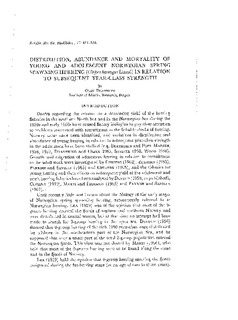| dc.description.abstract | 1. The distribution of young and adolescent herring in coastal and
offshore waters of northern Norway has been investigated for the 1959-
1965 year-classes by combined acoustic surveys and fishing experiments.
2. In the autumn (August-October) 0-group herring occur pelagically
in the upper 50 m of water together with the 0-group of several other
species, such as cod, haddock, redfish, capelin and others. This complicates
the charting and identification of the sound scatterers, but detailed
studies of the echo recordings and frequent sampling in the scattering
layer made it possible to determine the distribution of 0-group herring.
3. In 1959, 1960, 1964 and to some extent in 1963 and 1965, 0-group
herring had an oceanic distribution, and only a minor part of the 0-group
population entered the fjords of northern Norway. In 1961 and 1962 the
distribution was more restricted to the coastal areas, and a greater proportion
of the total 0-group population was present in the fjords. Herring
entering the fjords at the 0-group stage in the autumn emigrate during the
I-group stage from March to May.
4. Herring in the northern and eastern Barents Sea had slower growth
rates and consequently a longer phase of migration to the spawning areas
than did those distributed farther south and west. Herring from nursery
grounds in the Barents Sea, therefore, are considerably more reduced in
numbers before they reach the spawning grounds off Møre than those
which have spent their 0-group stage in the southern nursery areas in
Norwegian coastal waters. The growth rate, therefore, may influence the
migration pattern and the duration of the adolescent phase. Growth on
the other hand is determined by the distribution during the 0-group stage,
and the 0-group distribution consequently plays an important role in
recruitment mechanism.
5. Abundance estimates of 0-group herring were obtained from three
independent sources, i.e. acoustic surveys, catch and effort statistics and
tagging experiments. The 1959 year-class, but also that of 1960, were
numerous during the 0-group stage and remained abundant throughout
the adolescent phase and in the adult stock. Year-classes of low abundance
at the 0-group stage, such as the 1962 year-class, remained weak throughout
the subsequent stages. The 1963 year-class, which was fairly abundant
as 0-group, did not show up in significant numbers in the adult stock in
1968 and 1969. The 1964 and 1965 year-classes have not been studied
in their adult phase because they had not attained maturity when the
material was compiled. The year-classes of 1963 and 1964 showed about
the same relative strengths during the adolescent phase as at the 0-group
stage.
6. Mortality estimates obtained from catch and effort data and
tagging experiments indicate that the fishing mortality of 0- and I-group
herring in Norwegian fjords was relatively high, but because natural
mortality was much higher, the exploitation rate was relatively low.
Taking into account that the fjord population is only part of the total
0-group population, it is concluded that the fishing mortality generated
by the 0- and I-group fishery in Norwegian fjords was too small to be the
primary cause of the failure of recruitment to the adult stock.
7. A considerable increase in the exploitation of fat-herring, i.e. I- to
IV-group herring took place from 1965 to 1968. The increase in exploitation
during the adolescent phase of the 1963 and 1964 year-classes compared
with those of the 1959-1961, and a long duration of the migration
of the former year-classes from the nursery areas to the spawning grounds
may explain why the year-classes of 1963 and 1964 tended to be relatively
weak in the adult stock.
8. With the relatively low level of the spawning stock size an intensified
fishery on the Norwegian herring should be avoided. An extension
of the small- and fat-herring fisheries into the open sea may result in an
appreciable reduction in the subsequent abundance in the adult stock,
and a reduction of the fishery on young and adolescent herring should be
considered to improve the abundance of adult herring. | en |
